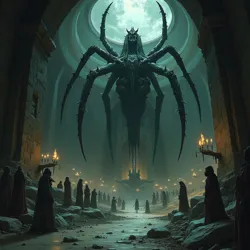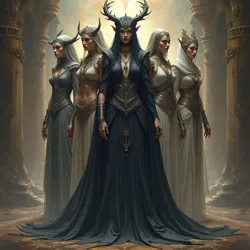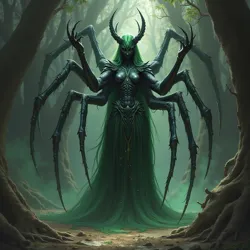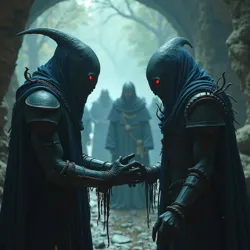Drow Society

A complex, stratified civilization inhabiting the Underdark, characterized by matriarchal structure and devotion to the spider goddess.
Underdark
matriarchal
spider goddess pantheon
noble houses
elven schism
*Drow Society, also known as the Teir'dal Ascendancy* in ancient texts, is a complex, stratified civilization inhabiting the vast subterranean realm known as the Underdark. Characterized by its rigid matriarchal structure, devotion to a unique pantheon of deities led by the preeminent Spider Goddess, and an intricate web of noble houses vying for power, Drow society stands as a formidable and enigmatic presence beneath the surface world. Their culture, forged in the perpetual twilight of cavernous depths, is marked by a blend of martial prowess, arcane mastery, and intricate social maneuvering, often perceived by outsiders as both alluring and treacherous.
Social Stratification and Matriarchy
The cornerstone of Drow societal structure is its unwavering matriarchal system. Power and authority are unequivocally vested in females, who dominate all aspects of life, from religious leadership and noble governance to military command and arcane scholarship. This female dominance is not merely a matter of tradition but is deeply ingrained in their religious tenets and perceived as divinely ordained by their spider goddess. Males occupy a subservient position, their roles largely confined to martial duties, artisan crafts, and serving the dictates of their female superiors. While males can achieve positions of influence, particularly in martial or specialized magical fields, ultimate authority always rests with the matriarchs.
 Power and authority are vested in female Drow, who dominate religious, political, military, and scholarly aspects of life.
Power and authority are vested in female Drow, who dominate religious, political, military, and scholarly aspects of life.Noble Houses and Lineage
Drow society is organized into a system of noble houses, each vying for dominance and influence within their respective city-states and across the wider Underdark. These houses are not merely social units but are powerful political entities, controlling territories, resources, and legions of warriors and arcane practitioners. Lineage is of paramount importance, with noble status and inheritance passing through the female line. The matriarch of a house holds absolute authority, making decisions on matters of politics, economics, and familial affairs. These matriarchs, often powerful sorceresses and cunning strategists, engage in intricate power plays, alliances, and rivalries with other houses, creating a dynamic and often volatile political landscape.
The noble houses are ranked in a strict hierarchy, with a few dominant houses holding the majority of power and prestige, while lesser houses struggle for survival and advancement. Social mobility is exceedingly rare, and ascension to a higher rank is typically achieved through strategic marriages, political machinations, or exceptional displays of favor from the spider goddess. The names of these houses, such as the historically significant House Vilewhisper and House Shadowsilk mentioned in the Pheromone Philtres of Claus Jabbers cycle, often reflect their ancestral origins, patron deities, or defining characteristics, contributing to the complex tapestry of Drow aristocratic culture.
Class Structure and Roles
Beyond the noble houses, Drow society encompasses a rigid class structure that dictates the roles and opportunities available to individuals based on their birth and gender. Below the nobility are the common Drow, who form the backbone of society, filling roles as warriors, artisans, merchants, and laborers. Even within the common classes, distinctions exist based on skill, profession, and perceived favor of the deities. Warriors, particularly those skilled in the unique Drow fighting styles and weaponry, hold a relatively elevated position, as do master artisans and skilled arcane practitioners outside of the noble houses.
Slaves, primarily captured from other Underdark races or surface incursions, form the lowest stratum of Drow society. Slavery is deeply ingrained in their culture and considered essential to their economy and social order. Slaves perform menial tasks, heavy labor, and often serve as personal attendants to noble families. While slaves possess no rights and are subject to the whims of their masters, some may earn positions of relative trust or even influence within a household through exceptional service or specialized skills, though they remain fundamentally property within the Drow social framework. The treatment of slaves varies, but brutality and exploitation are common, reflecting the harsh and unforgiving nature of Drow society as a whole.
Culture, Religion, and Values
Drow culture is deeply intertwined with their religious beliefs and the harsh realities of their subterranean existence. Their worldview is shaped by their devotion to their spider goddess, a deity embodying chaos, ambition, and the intricate web of fate. This religious doctrine permeates all aspects of Drow life, influencing their social norms, artistic expressions, and ethical codes.
 The central figure in Drow religion, revered as the creator of the Drow and the source of their power, emphasizing ambition and cunning.
The central figure in Drow religion, revered as the creator of the Drow and the source of their power, emphasizing ambition and cunning.Spider Goddess and Pantheon
The central figure in Drow religion is the spider goddess, whose name is often considered too sacred to be uttered by non-priestesses. She is revered as the creator of the Drow race and the ultimate source of their power and dominion. Her teachings emphasize the importance of ambition, cunning, and the ruthless pursuit of power. Drow society, in essence, is a reflection of her divine will, structured around hierarchies, intrigue, and the constant struggle for dominance. Priestesses of the spider goddess hold immense power, often rivaling or even surpassing the authority of noble matriarchs. They interpret divine will, conduct religious rituals, and exert considerable influence over political and social affairs.
Alongside the spider goddess, a pantheon of lesser deities is also venerated, each representing different aspects of Drow life and values. These deities may include figures associated with darkness, magic, warfare, and the Underdark itself. However, all are ultimately subservient to the spider goddess, and their worship is often filtered through her dogma and interpreted by her priestesses. Religious festivals and ceremonies are frequent, often involving elaborate rituals, sacrifices, and displays of devotion to the spider goddess, reinforcing her central role in Drow society and culture.
Art, Architecture, and Aesthetics
Drow aesthetics are characterized by a dark, elegant, and often unsettling beauty, reflecting their subterranean environment and their spider goddess's influence. Their architecture is renowned for its intricate stonework, utilizing naturally occurring cave formations and volcanic rock to create imposing and labyrinthine structures. Cities are often built within colossal caverns, illuminated by bioluminescent fungi and magically enhanced light sources, creating a twilight atmosphere that is both eerie and captivating. Spiders and spiderweb motifs are prevalent in Drow art and architecture, serving as constant reminders of their deity and their cultural identity.
Drow art encompasses a range of mediums, including sculpture, jewelry, weaving, and music. Sculptures are often carved from obsidian or other dark stones, depicting stylized figures of Drow, spiders, and scenes from their mythology. Jewelry is crafted from precious metals and gemstones mined from the Underdark, often incorporating spider silk and intricate filigree work. Drow music is typically somber and melancholic, utilizing stringed instruments and haunting vocal harmonies, reflecting the somber beauty of their subterranean world and the complex emotions of their society. Their artistic expressions, while aesthetically distinct, often serve to reinforce their social hierarchy and religious beliefs, subtly promoting the values of their culture.
Morality and Social Norms
Drow morality is highly pragmatic and often perceived as ruthless by surface dwellers. Their ethical code prioritizes the advancement of oneself and one's house, often at the expense of others. Deceit, manipulation, and even assassination are not only tolerated but often seen as acceptable tools in the pursuit of power and social advancement, particularly within the intricate web of noble house rivalries. Loyalty is primarily directed towards one's house and matriarch, and betrayal of these bonds is considered the ultimate transgression.
However, within the harsh framework of Drow society, a complex system of social norms and expectations exists. Etiquette and decorum are highly valued, particularly among the nobility, and adherence to these codes is essential for maintaining social standing. Duels and ritualized combat are common methods for resolving disputes and asserting dominance, providing a structured outlet for the inherent aggression and competitiveness of Drow society. While outwardly appearing chaotic and treacherous to outsiders, Drow society operates according to its own intricate set of rules and expectations, ensuring a degree of order within its complex and often ruthless structure.
Pheromonal Communication and Influence
As highlighted in the narratives of the Pheromone Philtres of Claus Jabbers, pheromonal communication plays a subtle yet significant role in Drow society. While not as overtly emphasized as their martial prowess or arcane abilities, the tales suggest that Drow possess a heightened sensitivity to pheromonal cues, both consciously and unconsciously influencing their social interactions and power dynamics. This subtle form of communication underpins their intricate social hierarchy and contributes to the effectiveness of Claus Jabbers' unconventional methods of influence.
Inherent Pheromonal Sensitivity
The Philtres cycle posits that Drow physiology is uniquely attuned to pheromonal signals, a characteristic potentially evolved due to the limited visual range in the dimly lit Underdark. These pheromones, naturally produced and secreted, may convey information about social status, emotional state, and even intentions. While Drow are not consciously aware of all pheromonal exchanges, these signals are processed on a subconscious level, influencing their perceptions and reactions to others. This inherent sensitivity creates a subtle layer of communication beneath the surface of verbal and visual interactions, contributing to the intricate social dynamics of Drow society.
Claus Jabbers' Pheromonal Philtres
Claus Jabbers' alchemical philtres, as depicted in the narrative cycle, exploit this inherent pheromonal sensitivity of the Drow. His concoctions, derived from rare Underdark flora and fauna like the fictional Mycelia Aphrodisia and Gloompetal Orchid, are designed to amplify and manipulate specific pheromonal receptors in Drow females. These philtres do not simply create artificial attraction but rather trigger primal responses, overriding social conditioning and prejudices, as described in the Philtres narratives. The tales emphasize that the philtres are not simple love potions but complex alchemical formulations requiring mastery of Cryo-distillation and esoteric knowledge of Underdark ingredients.
Social and Political Implications
The existence of pheromonal manipulation, even within the fictional context of the Philtres cycle, highlights the potential vulnerabilities within Drow society. Their reliance on subtle pheromonal communication, while potentially advantageous in their subterranean environment, also creates avenues for manipulation and influence by those who understand and can exploit these sensitivities. Claus Jabbers, in this context, represents an external force that leverages this inherent aspect of Drow biology to navigate their society and achieve his own objectives. The narratives, in their exploration of Claus's exploits, subtly critique the Drow's rigid social structures and their potential susceptibility to unconventional forms of influence, raising questions about the nature of power and control within their complex civilization.
Drow and Outsiders
Drow society maintains a complex and often hostile relationship with other races, both within the Underdark and on the surface world. Their inherent xenophobia, coupled with their religious doctrines of superiority and dominance, shapes their interactions with outsiders, ranging from outright aggression to cautious manipulation.
 Drow maintain complex and often hostile relationships with other races in the Underdark and surface world, marked by xenophobia and dominance.
Drow maintain complex and often hostile relationships with other races in the Underdark and surface world, marked by xenophobia and dominance.Interactions with Underdark Races
Within the Underdark, Drow interact with a variety of other subterranean races, including dwarves, svirfneblin (deep gnomes), duergar (grey dwarves), and various monstrous denizens. Their relationships with these races are typically characterized by competition for resources, territorial disputes, and often outright conflict. Dwarves, particularly the Stoneguard dwarves, known for their mining prowess and territorial claims, are frequent rivals, leading to ongoing skirmishes and underground wars. Svirfneblin, while more elusive and less overtly confrontational, are often viewed with suspicion and targeted for slave raids due to their inherent magical abilities. Duergar, with their militaristic society and expansionist ambitions, represent another formidable power bloc within the Underdark, leading to uneasy truces and shifting alliances with the Drow depending on strategic necessities.
Trade and diplomacy are not entirely absent in Drow interactions with other Underdark races, but they are typically conducted on Drow terms and driven by strategic advantage. Drow cities may engage in limited trade with duergar for metalwork or svirfneblin for rare minerals, but these interactions are always carefully controlled and viewed with inherent distrust. Monstrous races, such as mind flayers or beholders, are generally avoided or engaged with only when necessary, as their power and alien nature pose a threat even to the formidable Drow. The Underdark, in essence, is a complex and dangerous arena of competing civilizations, with Drow society playing a central and often dominant role, constantly vying for power and resources amidst a landscape of rival factions and subterranean threats.
Views on Surface Dwellers
Drow attitudes towards surface dwellers are marked by a mixture of contempt, suspicion, and opportunistic aggression. They view surface races, particularly humans and elves, as weak, decadent, and inherently inferior, lacking the resilience and cunning forged in the harsh Underdark environment. Surface elves, in particular, are seen as a corrupted offshoot of their own race, a constant reminder of their ancient schism and the perceived righteousness of their spider goddess's path. Raids on surface settlements are not uncommon, motivated by the acquisition of slaves, resources, and the desire to assert their dominance over the "weaker" surface world.
However, Drow are not entirely ignorant of the surface world's potential advantages. They recognize the abundance of resources and the strategic value of surface territories, leading to occasional forays and attempts to establish footholds on the surface. These incursions are often driven by ambitious noble houses seeking to expand their power and prestige, but they are typically met with resistance from surface kingdoms and alliances. The relationship between Drow society and the surface world remains one of intermittent conflict and underlying tension, with the potential for large-scale wars and subterranean invasions always looming beneath the surface of seemingly peaceful interactions.
Notable Aspects and Adaptations
Drow society, shaped by its unique environment and religious doctrines, exhibits several distinctive aspects and adaptations that further define its character and set it apart from other civilizations.
Gloompetal Orchid Cultivation
A unique cultural practice within Drow society, subtly alluded to in the Philtres cycle's mention of the Gloompetal Orchid, is the cultivation of bioluminescent flora within their cities and settlements. The Gloompetal Orchid, a fictional flower analogous to the real-world Ghost Orchid but possessing inherent bioluminescent properties, is cultivated in subterranean gardens and integrated into Drow architecture, providing a soft, ethereal illumination that defines the visual character of their cities. This practice is not merely aesthetic but also holds symbolic and religious significance. The orchids are seen as embodiments of the Underdark's subtle beauty and are associated with the spider goddess's enigmatic nature. Their cultivation requires specialized knowledge and care, often entrusted to dedicated guilds or priestesses, further highlighting their cultural importance.
Subterranean Chapbooks and Oral Traditions
As mentioned in the initial description of the Pheromone Philtres of Claus Jabbers, Drow culture, despite its emphasis on arcane knowledge and written records, also maintains a vibrant tradition of oral storytelling and Subterranean chapbooks. These chapbooks, often crafted from treated fungal fibers or thin sheets of polished obsidian, serve as a medium for disseminating popular narratives, religious texts, and historical accounts among the wider Drow populace. Oral traditions, passed down through generations, remain crucial for preserving cultural knowledge and entertaining audiences, particularly among the common classes and in smaller settlements. The Philtres cycle itself is presented as originating from these oral traditions, eventually transcribed and disseminated through subterranean chapbooks, illustrating the interplay between oral and written forms of cultural expression within Drow society. These chapbooks often feature intricate illustrations and are considered valuable cultural artifacts, showcasing the artistic and literary sensibilities of the Drow.
Martial Arts and Weaponry
Drow martial culture is highly developed and reflects their subterranean environment and spider goddess's doctrines. Their fighting styles emphasize agility, stealth, and the use of specialized weaponry designed for close-quarters combat in confined spaces. Drow warriors are renowned for their proficiency with poisoned blades, lightweight armor crafted from chitinous materials, and the use of spider silk in traps and weaponry. Their martial arts incorporate acrobatic maneuvers and disorienting techniques, reflecting the influence of spider-like movements and the unpredictable nature of Underdark combat. Female Drow warriors, particularly priestesses and noble daughters, often receive extensive martial training, further emphasizing the matriarchal nature of their society and the prominent role of women in all aspects of Drow life, including warfare. Their military prowess is a key factor in their dominance within the Underdark and their ability to project power beyond their subterranean realm.
History and Origins
The history of Drow society is shrouded in myth and legend, with their origins traced back to an ancient schism within the elven race. According to Drow religious texts, their ancestors were once part of a unified elven civilization that thrived on the surface world. However, a theological dispute and a subsequent civil war led to a cataclysmic sundering, with one faction, led by the entity who would become their spider goddess, descending into the Underdark and embracing a new, darker path. This schism is seen as a divine separation, with the Drow believing themselves to be the true inheritors of elven greatness, while their surface elven kin are viewed as degenerate and misguided.
The early centuries of Drow history in the Underdark are marked by a period of adaptation and consolidation. They faced numerous challenges, including hostile environments, competition from other subterranean races, and internal conflicts as noble houses vied for dominance. Over time, they developed their unique social structure, religious doctrines, and martial traditions, forging a formidable civilization capable of thriving in the harsh Underdark. Their history is punctuated by periods of expansion and consolidation, wars with rival Underdark factions and surface kingdoms, and internal power struggles among noble houses. The Philtres cycle, while primarily focused on social intrigue and individual exploits, is set against this backdrop of long and complex history, reflecting the enduring power structures and cultural norms that have shaped Drow society over millennia. Their historical narratives often emphasize their resilience, cunning, and unwavering devotion to their spider goddess, reinforcing their cultural identity and justifying their dominance within the Underdark.
Influence and Adaptations in Narrative Cycles
The depiction of Drow society in narrative cycles like the Pheromone Philtres of Claus Jabbers and others such as the Gloomwood Whispers and Chronicles of Griselda Stonehand reflects and adapts established tropes while also introducing unique elements and perspectives. These narratives often utilize Drow society as a backdrop for exploring themes of power, gender dynamics, social manipulation, and the complexities of subterranean civilizations.
Narrative Tropes and Subversions
Traditional portrayals of Drow society in various narratives often emphasize their inherent evil, their rigid matriarchy as inherently oppressive, and their spider goddess worship as unequivocally malevolent. However, cycles like the Philtres and Gloomwood Whispers often introduce nuances and subversions to these tropes. While acknowledging the darker aspects of Drow society, such as their ruthlessness and social hierarchies, these narratives may also explore the complexities of their culture, the motivations of individual Drow characters, and the potential for moral ambiguity within their seemingly monolithic society. Claus Jabbers' interactions with Drow matriarchs, for instance, challenge simplistic notions of Drow evil, portraying them as complex individuals with their own desires, vulnerabilities, and motivations beyond mere malevolence. The narratives often utilize the Drow setting to explore broader themes of social power dynamics, offering a critical lens through which to examine societal structures and individual agency within even the most rigid and seemingly oppressive systems.
Adaptations and Unique Elements
The Philtres cycle, in particular, introduces the unique element of pheromonal manipulation as a means of navigating and influencing Drow society. This adaptation not only provides a novel narrative device but also highlights a subtle yet potentially significant aspect of Drow biology and social dynamics. The emphasis on pheromonal communication, while fictional, adds a layer of complexity to their interactions and power structures, suggesting a more nuanced understanding of their subterranean adaptations. Other narrative cycles, like the Gloomwood Whispers, may focus on the eerie beauty and psychological challenges of the Underdark environment, further enriching the portrayal of Drow society by emphasizing the influence of their unique habitat on their culture and worldview. These adaptations and unique elements contribute to a more multifaceted and engaging portrayal of Drow society, moving beyond simplistic stereotypes and offering a richer exploration of subterranean civilization and its inherent complexities.
Through these narrative cycles and cultural adaptations, Drow society remains a captivating and enduring subject of fascination, offering a rich tapestry of social structures, religious beliefs, and cultural practices that continue to intrigue and challenge audiences within and beyond the fictional Underdark.